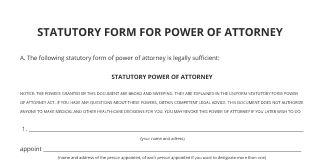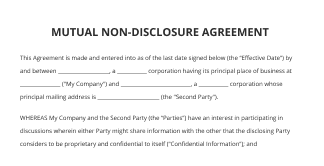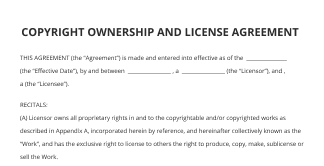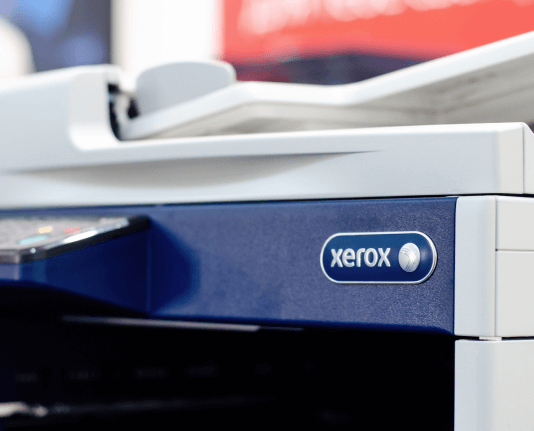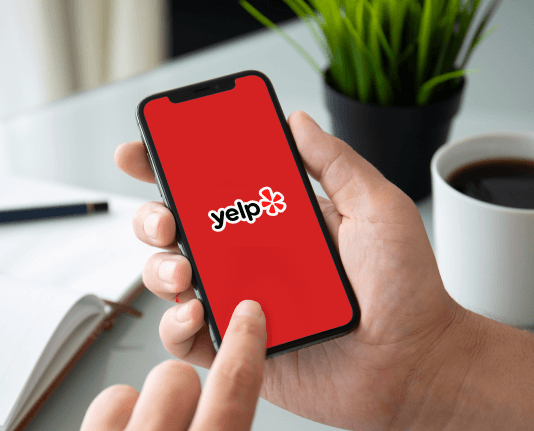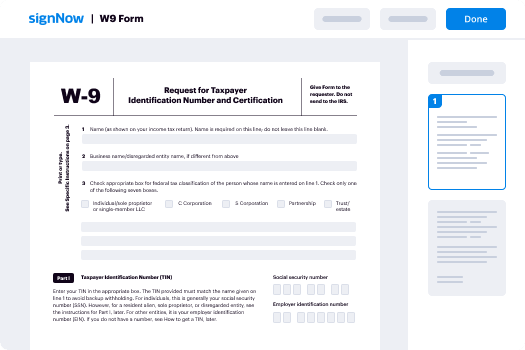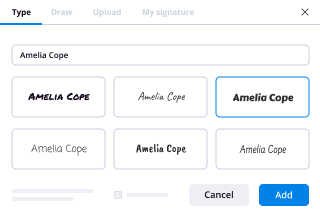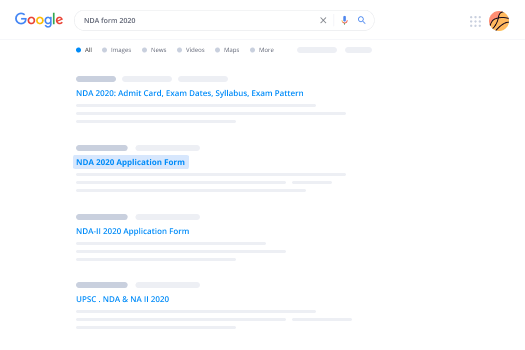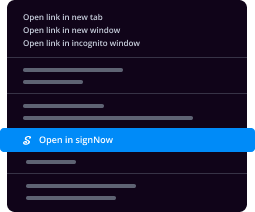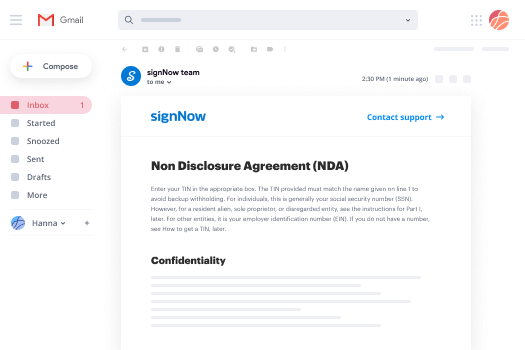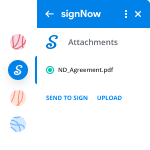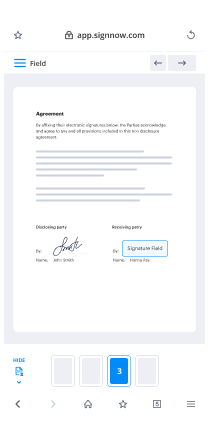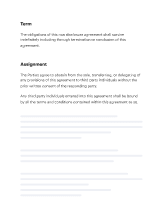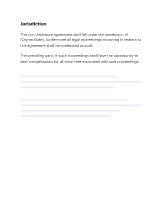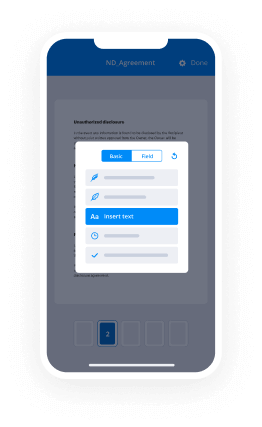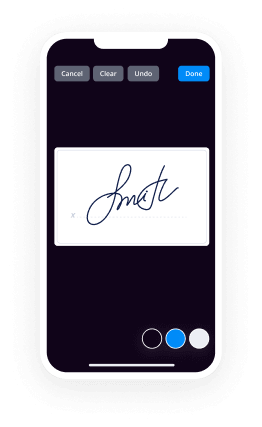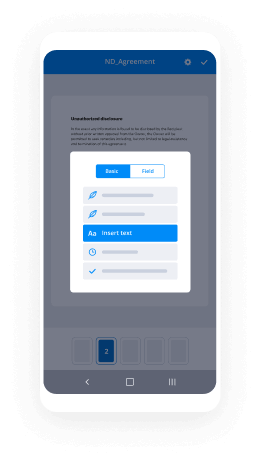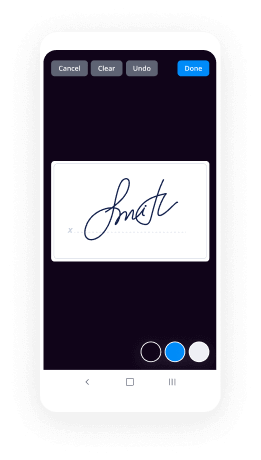Historial Médico Infantil De Firma Hecho Fácil
Mejore su flujo de trabajo de documentos con airSlate SignNow
Flujos de trabajo versátiles de firma electrónica
Visibilidad rápida sobre el estado del documento
Configuración fácil y rápida de integración
Historial médico infantil de firma en cualquier dispositivo
Registro detallado de auditoría
Normas estrictas de protección
Vea las firmas electrónicas de airSlate SignNow en acción
Soluciones de airSlate SignNow para una mayor eficiencia
Las reseñas de nuestros usuarios hablan por sí mismas






Por qué elegir airSlate SignNow
-
Prueba gratuita de 7 días. Elige el plan que necesitas y pruébalo sin riesgos.
-
Precios honestos para planes completos. airSlate SignNow ofrece planes de suscripción sin cargos adicionales ni tarifas ocultas al renovar.
-
Seguridad de nivel empresarial. airSlate SignNow te ayuda a cumplir con los estándares de seguridad globales.

Tu guía paso a paso — signature child medical history
Con la firma electrónica de airSlate SignNow, cualquier negocio puede aumentar los flujos de firma y firmar en línea en tiempo real, brindando una experiencia mejorada a clientes y empleados. Use historial médico infantil de firma en unos pocos pasos sencillos. ¡Nuestras aplicaciones móviles portátiles hacen posible trabajar en movimiento, incluso sin conexión! Firme contratos desde cualquier lugar del mundo y complete acuerdos más rápido.
Cómo completar y firmar un signature child medical history
- Inicie sesión en su cuenta de airSlate SignNow.
- Busque su documento en sus carpetas o importe uno nuevo.
- Abra el documento y realice ediciones usando la lista de Herramientas.
- Arrastre y suelte cuadros rellenables, agregue texto y firme electrónicamente.
- Liste varios firmantes por correos electrónicos y configure la secuencia de firma.
- Indique qué destinatarios recibirán una versión completada.
- Utilice Opciones avanzadas para restringir el acceso al documento y establecer una fecha de expiración.
- Presione Guardar y cerrar cuando termine.
Además, hay herramientas más extendidas disponibles para historial médico infantil de firma. Liste usuarios en su espacio de trabajo digital compartido, vea equipos y siga la colaboración. Numerosos usuarios en EE. UU. y Europa reconocen que un sistema que integra todo en un entorno cohesivo, es exactamente lo que las empresas necesitan para mantener los flujos de trabajo sin esfuerzo. La API REST de airSlate SignNow le permite integrar firmas electrónicas en su aplicación, sitio web, CRM o nube. Explore airSlate SignNow y obtenga flujos de firma electrónica más rápidos, suaves y en general más efectivos!
Cómo funciona
Funciones de airSlate SignNow que los usuarios adoran
Vea resultados excepcionales signature child medical history
¡Obtenga firmas legalmente vinculantes ahora!
Lo que dicen los usuarios activos — signature child medical history
Signature child medical history
welcome everyone to Wednesday night's lab I'm Tamsin and I work here at the uw-madison biotechnology Center I also work for UW extension Cooperative Extension and on behalf of those folks and our other cool organizers Wisconsin Public Television Wisconsin Alumni Association and the UW Madison science Alliance thanks again for coming to Wednesday night at the lab we do this every Wednesday night 50 times a year tonight it's my great pleasure to introduce to you Walt shallick he was born in Pittsfield Massachusetts as was my mother-in-law he went to Roger Ludlow High School in Fairfield Connecticut and then did his undergraduate work at Washington University in st. Louis where he majored in English and physics which a lot of people do because English and physics then he went to Johns Hopkins in Baltimore and got both a medical degree and a PhD his PhD was in the history of medieval medicine and then he did several fellowships and pediatrics and Rehab he came to you to be Madison ten years ago in 2007 tonight he's going to talk about a topic that's near and dear to my heart because I grew up in Dixon Illinois and in Dixon Illinois was the Dixon state school as we called it when I was a kid and how we looked at well how we've changed and how we look at people with disabilities it's a big deal to me because that's the water that I swam in his topic tonight is child leaing the crippled and crippling the child children with disabilities in American science and policy 1912 to 1961 welcoming Walsh Alec to Wednesday night at the layout [Applause] well thank you everybody and I want to have a great shout out to the team here at Wednesday night at the lab and to Tom my family and I have been avid followers both online and in person at once denied the lab and I have to indicate that it feels to me rather like a Thanksgiving dinner every time we participate in one of these in part because you have interesting people sitting around the proverbial table but also because it's kind of like having crazy Uncle Tom with his marvelous sense of humor and his great status is a raconteur bringing you all kinds of tales that you never thought about so I'm really grateful for that and I asked Tom before we started whether or not he'd ever thought of publishing the vignettes that he does in the intros for the email and I think he desperately needs to do that so we should all encourage him to do so and when it's a runaway bestseller the money can partially come back the Wednesday night at the lab I'm sure so that being said I trained as a medievalist in part and when Tom and I had first met and talked about things we deposited me talking about some of my team evil work which I'm happy to do but of the many talks I offered to him he chose this one and so first and foremost I have to indicate that I had no financial disclosures and and this talk should be free of bias I hope that being said since I come by this slide honestly as Tom noted one of my first passions was physics and I'm working on some a project on the history of quantum mechanics but we're gonna be very much like this slide tonight and I apologize ahead of time I'm going to try to follow this running of the tongue so after a brief intro we'll talk a little bit about the contemporary science of traumatic brain injuries Tom had suggested that maybe I should include some modern scientific work in since some of my network based research is on that subject it seemed reasonable but then we'll will slide into the history of kids with disabilities over the in the 20th century and then come to a couple of conclusions if we're lucky I wasn't going to say this but I'm I decided it's better to disclaim now the the organizers have said that I've got time on my hands and you do not want to tell that to a professor because they just keep going and going I will desperately try and keep this shorter than it could be otherwise I'd like to start with a story and this is a story of an inquisitive simian I thought his name was Jorge but it turns out it was Jorge one day George came across a puzzle box and he opened it up and being inquisitive he saw these many colored shapes and he thought maybe they're candy and he tried one of them unfortunately they weren't candy and very soon he didn't feel well now he had to eventually go to the hospital and his companion the man with the yellow hat took him to the hospital we will return to this hospital little later and he was waiting in the emergency room and he met two children before he was eventually seen by a nurse and doctor and we will come back to those children in a moment he eventually got an x-ray and eventually had a small surgical procedure he needed to recover because at that point his HMO was very generous in the amount of time it would give him and it was not an outpatient procedure he made friends in the hospital including a boy in a go-cart which if anybody remembers that you can ask me about the go-kart in the question and answer now being inquisitive Jorge also got into trouble with the go-kart but things ended well now I told you that story to tell you this story the two children he was sitting next to were Jill and Jack now it turns out that Jill and Jack lived in a rural area of town they didn't have running water one of their chores was every morning to wake up and carry a pail up this this winding path to get water and bring it back to their parents that day that George was in the hospital they both tumbled down the hill now Jill was fine she had some minor contusions and bumps but she was fine jack on the other hand bumped his head and he'd to sustained a traumatic brain injury traumatic brain injuries are not good my wife actually used to play hockey of field hockey and she sustained a number of them and we are both worried about that as she gets more mature nevertheless traumatic brain injuries are much in the news for a variety of his reasons not the least for veterans and those in harm's way but certainly also for those in harm's way playing professional football I chose this image very carefully traumatic injuries brain injuries or TV eyes as we call them are bad for a variety of reasons you do not need to read the contents of the slide just take away they're bad for kids TV eyes are also bad they're bad in part because they caused nearly 7,500 deaths they generate 60,000 admissions to the hospital and 600,000 ER visits a year in the u.s. they are one of the main causes of death and disability so in fact if you combine those two they're the main cause of death and disability in the u.s. for children they're the fastest-growing group of disabilities in the u.s. because of increased survival rates and somewhere between two-thirds and three-quarters of cases are mild and many are missed and as a consequence it's called a silent epidemic so this is an important topic for those of us in pediatrics and in pediatric rehabilitation not the least because of bike bike helmets spending time on campus with any of a number of my students riding bikes and mopeds this is my big public service announcement for the evening and to those on line please wear your helmets many of the students I see are talking on a cell phone have no helmet and are either on a moped or a bike one-handed this is a reason we have an extremely good transplant surgery program and it shouldn't be that way because these kids are putting money into their education the brain is the thing that should be important in this case though garthe is finally wearing his helmet but he's worried he's going to get a him injury from the boring teacher and I hope that doesn't happen to you tonight now broadly the mechanism for developing a traumatic brain injury is because of gravity if you will and one of Newton's laws that is when an object is in motion it tends to stay in motion until acted upon by an outside force and either the acceleration or the deceleration or in the case of motor vehicle accidents is going to get you we tend to think of traumatic brain injuries as having an initial impact but in fact the brain tends to slosh within the skull and so you get both an initial impact and a secondary impact on the other side of the skull that in itself is bad enough the regions of the brain can be affected are very sensitive tender if you will and can cause all kinds of disabilities in addition though there are torsional injuries that occur and there in fact there's bleeding and swelling of the brain and all this is bad it generates both death and disability but with these images you can see one of the tools we use in emergency medicine pediatrics rehabilitation orthopedics and neurosurgery to find out whether we've got a bad brain injury on our hand or not turns out that about half of the kids assessed for head and head injuries will get a cat scan it makes sense you want to see inside the brain to find out if there's a problem is there a bleed is there swelling is there more diffuse injury and the number of cats canes that have been used has doubled over the decade from 95 205 but less the fewer than 10% of minor hinge head injuries actually show trouble on cat scans that in and of itself is interesting are we over using cat scans well it turns out there's a downside to cat scans that between one and a thousand and one at five thousand cat scans will cause a lethal malignancy in children that is also bad so on the one hand we have bad brain injuries and we on the other hand we have cancer that we're causing trying to find that balance is a project that a group of us in a network addressed a few years ago P carne is a consortium of 25 pediatric emergency rooms it's the first federally funded pediatric network of pediatric ER network and our goal is to do high quality research in order to help kids in acute settings and eventually in chronic settings and it's funded by the federal government through a series of agencies then that with network is composed of centers from New England all the way to California and happily there's one in Milwaukee and a number of years ago in fact this was one of the first studies we began to work on one of our whoops sorry about that one of our lead researchers Nate Cooperman who's one of the most extraordinary scientists for pediatric emergency medicine in the country and also most one of the most incredible human beings you could possibly meet we began a project to try and figure out how to balance investigating traumatic brain injuries and minimizing cat-scans the next three slides are meant to be just visual don't look for the content the key here is that we brought we examined about almost 60,000 children Wynand them down to about 42,000 children and broke them into two groups the larger group we use to try to derive a decision rule to decide what do you do when a kid comes in with symptoms and they might or might not have a traumatic brain injury do you cat scan them do you not cat the scan them and the smaller group we use to validate the decision will decision rule we eventually created takeaway from this slide that we looked at a lot of different symptoms and signs and we used a lot of statistics to dry engine try and generate the decision rule and finally the decision rule came out rather like this we divided it into less than two years old and greater than two years old and then looked at what was the most efficient way of determining who needed a cat scan and who didn't this was the largest study of its kind ever made in part because it was used it was generated through the peak or network and the rule that we created was between 97 and 100 percent sensitive depending on the age of the child you were looking at and I hope that if any of you have children or grandchildren who sustained a head injury that is being used in an ER near you now that's all well and good maybe that helps with cats camps but what about actually trying to prevent the disease and the death and disability that come from traumatic brain injuries and children we've also been looking at this one of the keys we've tried to do is a pharmacological intervention and it turns out so far we've had no success the first focus was on steroids one of the downsides of traumatic brain injuries I mentioned was swelling of the brain steroids are used to reduce swelling makes sense we use steroids if you have swelling as a consequence we've used that for many decades in medicine to try and we thought helped kids with with traumatic brain injuries Ian Roberts is an extraordinary researcher at the University of London he ran a huge trial of steroids in traumatic brain injuries that was published in The Lancet looking at more than 10,000 adults and it was really clear from that study that steroids didn't help if anything people who were getting the steroids still a little worse so as a consequence we're not using steroids anymore are there any other opportunities well for another friend of ours I'm Don Stein down at Emory who's a bench scientist noted that when he was studying traumatic brain injuries in animals particularly in rice rice and mats so rats and mice and he noticed that the the pregnant mice didn't seem to have as much trouble with traumatic brain injuries as the non pregnant mice now I think one of it is the natural superiority of women over men I need to say that because I have a wife and a daughter and it's true but he thought that there must be a biological basis for this too and eventually he drilled down and determined that progesterone seemed to be the hormonal difference that led to the bed for pregnant mice a large trial called the protect three trial followed two previous studies that seemed to show that in human beings progesterone made a difference and our group was doing a project that was NIH funded to begin to apply it in children and then the protect three results came out and it turned out the progesterone didn't work either so we went back to the roaring board yes the flame out stops on txa is it's a synthetic molecule that has been used in trauma in other settings TXA is a is a chemical that will interrupt the conversion of one one chemical plasminogen into plasma in which in the body cuts down breaks down clots and that you can imagine would be bad if you're bleeding out in some fashion so stop the bleeding out it turns out that it may also be useful in traumatic brain injuries for reasons we don't fully understand but TXA will interrupt this pathway and as a consequence we are I'm getting ahead of myself as a consequence we are looking at running a trial of TXA and children with traumatic brain injuries have an NIH planning grant to do this and are hoping to then take it into a randomized placebo-controlled trial soon we don't know if it's going to work we've struck out twice we're hoping we'll still be at bat at the end all right this is one approach to disabilities and I'd be happy to answer more questions afterwards but where I really spend my time is in history and when you look at brain injuries and you look at other kinds of disabilities you're entering a new world this is an image from outside on our apartment in Paris when I was doing some of my archival work and the reason I use it is to highlight what I was just telling you and distinguish it from what I want to talk about for the rest of the evening there are two core models of disability one is the medical model that which I've just shown you and the other is the social model the medical model argues that disability stems from some fundamental aspect of an individual either an illness or an intrinsic in disability that represents a physical condition now that doesn't mean it can't be a psychiatric disability or some other sensory disability but it is in some way physically based on the body and it is intrinsic to the individual it's part of who that individual is it can reduce the individual's quality of life and it can Claus and cause clear disadvantages to the individual and as a result of that definition that conceptualization managing a disability really revolves around identifying the illness or or the disability understanding it and learning to control and alter its course through the individual I just demonstrated that with the research that I've been doing right all of this is about changing the individual's body kid comes in with possible TBI cat skin or not progesterone or not steroids are not TXA or not to the individual the the success of the medical model has been rolled out for example by the World Health Organization in 1980 they created a model of disabilities that suggested that you've got this linear process of a disease or disorder leading ineluctably to a handicap in which an impairment is the exteriorized version of the disorder the disability is some objectified measurement of that impairment and the social consequences of that linear process or a handicap easiest way to think of this is a condition that has been characteristic of human beings since we came down from the trees along with George if you look at hydrocephalus it's a native condition that we can get at any point in infancy and before birth and infancy and it's basically an interruption of our dysregulation of the cerebral spinal fluid around the brain you can imagine a with unchecked hydrocephalus would find it hard to sit in school because their head would be too heavy for their neck muscles some of you may be having the same problem tonight but that's because I'm a boring lecturer and not because of your hydrocephalus but using this model hydrocephalus is the disorder an enlarged head as the impairment the inability to set up is the disability and you can't go to school becomes the handicap very logical very linear linear the whu-oh knew what they were doing at the time the problem is this is not the only part of the story the last time our son is not backwards he's just dyslexic it's a matter of definitions in perspective so the social model of disability argues that even though there can be physical difference the bigger feature here in when whether somebody has or does not have a disability are the it comes from the barriers the native prejudice and exclusion that society generates itself it can be intentional it can be unintentional and those though are the ultimate factors that define disability that doesn't mean that everybody is created equal in some physical sense we have natural differences but how we respond to those differences through the built environment through our institutions and organizations that's what it's all about think for a moment of buses if you're a wheelchair user or have a broken leg and need a crutch it can be very hard to get onto a bus before we started creating kneeling buses with bus architecture we had created a disability a social handicap if you will and that began to be minimized by this social response of altering the structure of the buses the easiest way I can get this across is a case this is a real-world case from the 1950s a midwife noticed that a child who had been born had creases across its hands had slightly down slowly sloping eyelids and compared to other kids it was what we used to describe a newborn medicine loosey-goosey is flexible by the age of two it had just begun to say a few halting words and to stand so it was delayed as we would think of him and by 18 though it could speak though not quite as well as its peers on this Pacific island without apples and video conferencing and all the rest of it this child became as a gatherer of firewood got married had children and lived to about the same age as everybody else on this island now this child in fact this is not the picture of the child but this is in fact another child with the same condition that child was born with Down syndrome in 2017 child born with Down syndrome in Madison has a consequential disability for a variety of reasons but on that island in ninth in the 1950s there was essentially no disability and it's the difference between the social context the condition is the same but the context is different you can imagine that with the social model of disability there are a lot of political consequences by which I mean little P it is in fact the intellectual basis for the disability rights movement that paralleled the civil rights movement and the human rights movement coming out of the 1960s there's a lot more that could be said about it but I'm not going to go there tonight I will acknowledge though that the World Health Organization in 2001 said oh maybe we screwed up in 1980 we're going to recreate our model of disability and come up with a model that takes account of environmental factors individual circumstances as well as the health condition to try and define the presence/absence and nature of disabilities the downside of this marvelous model the International classification of function the original manual that went with the 1980 definition was really small this one as we say in Boston is wicked big it's very hard to operationalize this from a research point of view but it's far more accurate and just okay so that's all great wall where does any of this come from that's where the history comes in I've always loved this cartoon I'll need some medical history ma'am what year was anesthesia discovered you should all be afraid that doctors are going to start doing this the work I've been doing golly it's almost it's been 15 years has taken me to archives across Europe in the United States trying to find information about the clinical experiences of the scientific investigation and and support of the public policies around and the social stigmatization of em experiences of children with disabilities in Western Europe in the United States Abraham Jacobi was a figure who was born and raised in Germany learned what would become pediatrics and brought it into the United States and he's conventionally called the father of American Pediatrics in in pediatric residency you are to some degree learned to idolize Abraham Jacobi but Abraham Jacobi was not without sin from a modern point of view unfortunately for my daughter who was born in st. Louis this lecture occurred in st. Louis in the year of the World's Fair and he was speaking amongst many things about inherited conditions that led to disabilities and he argued that for families in which man has epilepsy or consumption and choose it to marry at the time they thought this would lead genetically to the propagation of these conditions and as a consequence then one-half of us should not be destined to watch a nurse and support the other half human society in the state to protect themselves by looking out for healthy uncontaminated progeny and laws are required to accomplish this it's unfortunate that while health and virtual are as a rule not contagious disease and vice are so to a high degree and you can hear the moralism in this and the consequences that came about now Jacobi was not without resonance with interest at the time and one of the big motivators around disability was jus Jetix at the time eugenics was not a concept that Charles Darwin had generated but one of his relatives did and the principle was in some ways we ought to be able to manipulate the evolution of chickens and human beings to be able to make both better in the 19-teens in Chicago and a surgeon named Harry Hazelden was called to attend a deformed newborn at its birth at the time he decided to allow the child to die and in rather like I can use this name with this audience because you'll all know jack kevorkian an early jack 14 at the time he had a friend who was a reporter with the Chicago American told the story then a newspaper article was written harry Hazelden got quite a bit of publicity about this not the least because people were very interested in eugenics at the time and he also was interested in movies and made a movie about his experience the movie was called the black stork and in the movie he I do not know where they found this marasmus child to be an actor in the movie but he comes up to this child and goes through a thought experiment but whether he should save the child he in the thought experiment he decides to save the child he has the nurse come and help him he operates on the child at the time it would have made no sense but that's the way it was and he goes through what will happen is this child gets older while the child would still have deformities still have disabilities and would be shunned by his playmates he would as Rudolf not be allowed to play in reindeer games and feeling that social opprobrium he eventually would turn to a life of crime he would go to jail and years from then when he was left out of prison he would ask why did he go to prison in the first place and he would remember that his mother told him that a surgeon had saved his life he would go find that surgeon and with a terrible resonance with what has had been happening in the United States over the last year and Beyond he would shoot the surgeon so in this experience this thought experiment rather like Albert Einstein Hazleton was saying he I am going to be propagating my own death in the future and the terrible experience of this child rather I'm going to let this child pass away now anticipating George Lucas and the extraordinary special effects that would come in movies he had an overlaying image of a figure receiving a handkerchief on a wire as the child's spirit goes into the waiting arms of Jesus so in this movie the black stork everything ends well because the child is allowed to die and it worked well for eugenics impressions at the time now disabilities of a variety of kinds at that time we're seen as a center point the hub of the spoke of many different social ills and as a consequence it is not surprising that the Supreme Court itself led by Supreme Court justice just blanked his name it's terrible and father and son father was an internist at Harvard Oliver Wendell Holmes jr. thank you very much otherwise a very sage Supreme Court justice ruled on on a famous case called buck vs. Bell that the state should be allowed to compulsorily sterilized those who had intellectual disabilities in order to protect the interests of the state because in this way we would be able to free the gene pool of such defectives our culture has not been without sin if you will we exported the eyes these ideas to Germany I had a wonderful movie that if we have time I will show at the end that the National Socialists propagated in the 1930s to make those exact arguments to argue for what would be a lead point for the final solution and the Holocaust in sweeping up children with disabilities taking them to constant concentration camps and euthanizing them in fact this is part of a wider argument that I've been following that over the last 200 years these four countries amongst others have acted as a kind of syncytium a giant cell that's formed from several to exchange ideas and people around kids with disabilities and his eyes these ideas have moved ultimately I've wanted to understand how we've come to our contemporary ideas there are many stories that can come out of this work but what I want to share with you for the rest of the time tonight is the story coming out of the United States now overall there are three core themes that come out of these topics one is numerous ation the other is holism and the third is normalization these three themes play out at different times in different places in different ways but in the United States they came out mostly like the following FDR was famous for being president for surviving helping us survive the depression and World War two but also for having polio so having a disappearance with disabilities finally though for his his fireside chats on the radio and in 1934 he gave one that is particularly interesting modern medical science has advanced so far that a very large proportion of children who for one reason or another have become crippled can be restored to useful citizenship it remains therefore only to spread the gospel for the care and cure of crippled children in every part of this currently land to enable us to make the same relative progress that we've already made in the field of tuberculosis there are so many more of them than we had any idea of in many sections there are thousands who are not only receiving no health but whose very existence has been unknown to the doctors and health services now despite my horrible FDR accent the ideas that come out of this are kids with disabilities are important they are salvageable and they can be brought into useful citizenship a concept that I hope we'll see at the end one of the effector arms one of the agents of change for FDR and others was the US Children's Bureau which in 1940 argued that they were bringing to light information not heretofore available for all the states of the Union about the numbers and location of crippled children the causes of their conditions and the care such children need as well as the costs of that care many of these ideas came not from FDR but rather from women again Jane Addams who is often seen as one of the pioneers of social work and her programs at Hull House in Chicago was a great proponent of if you will social statistics looking at maps and gathering information from surveys categorizing this data through statistics and understanding how people can be boiled down into numbers one of her protege Julia Lathrop went on to become the first director of the US Children's Bureau the Children's Bureau founded in 1912 the reason for my stay on my starting point for the historical part of this talk became one of the greatest social agents of change for children in the United States but because Julia Lathrop was at its heart a great deal of what the Children's Bureau did was look at statistics and gathering information they were not alone it turns out in the beginning years of the Children's Bureau people were worried about those disabilities and children because of eugenics it was a hot potato it was not politically good to worry about those topics so instead in those early years many private organizations went out trying to gather the statistics the Rockefeller Foundation in New York noted there were about 36,000 cripples in New York roughly seven and a thousand inhabitants interesting in the statistics a half were yet younger than 16 another 13% were noted to have the onset of their condition at 6 less than 16 so about two-thirds of the disabilities in New York at that time were related to childhood and one of the conclusions of that report was that the crippled problem as they called in and so far as it relates to prevention is largely one of childhood and rehabilitation or after care is the tool to prevention Bob Kelso who was an executive director in Massachusetts for the board of charity in 1921 wrote a report for the Children's Bureau and argued again that rehabilitation can do so much for crippled children and the swear charitable organizations cannot help the state government is obligated to supervise home and institutional care so acting as a kind of antagonist to the images that Abraham Chacon he was offering and certain certainly Harry Hazelden Bob Kelso and eventually the Children's Bureau would begin to look for ways of helping kids with disabilities certainly at this time charity was the primary agent of support for people of all kinds with disabilities but often they were left behind maybe Santa Claus thought nobody lived here there were a number of organizations particularly institutions for kids with disabilities not unlike Tom's experience growing up pediatric institutions for disabilities began in the 1860s on the East Coast by the late last decade of the 19th century that it's they'd spread as far as Minneapolis and then had grown in numbers by the time the Children's Bureau was established many of these institutions would become seminal in helping kids with disabilities but they were not alone there was in fact a clarion call that goes out in the 1920s and 30s for helping children with disabilities and one of the lead voices in that clarion call was a senior senator from michigan Senator Jim cousins who approached Herbert Hoover then known not for the depression but as the children's president that he should invoke a White House Conference on the topic of children with disabilities Hoover thought about it new eugenics was on the decline in the United States still thought it was a bit of a hot-button topic because untight and decided to in fact have a conference more widely on the health of children in general this he saw as a way of improving the if you will the race of the United States making us be able to walk into our future with greater and greater health I'd like you to think of this image in comparison to the brief story I told you about what was happening in Germany over the same period of time now the White House Conference was in fact not exclusively devoted to children with disabilities but had one quarter that devoted to that topic partially as a cloak partially in order to diffuse more of the interest to help children at large the Children's Bureau eventually would become the outcome product Ford making differences for kids with disabilities after the White House Conference but the biggest change would come about because of the Social Security Act of 1935 and FDR the roots of the Social Security Act come from Wisconsin not the least from the economists who are on faculty at UW at the time one portion of the Social Security Act title 5 was devoted to allocating new resources from the federal government to help children with disabilities in 1935 dollars the total amount of money between the amendment and 39 and the original proposition was about 4 million dollars what this did is inspired physicians nurses social workers therapists and any of a number of support specialists to increasingly work to help children with disabilities how to distribute that money was a critical question though so the Children's Bureau was still figuring out where these kids were do we need to put more of the money into the home of a powerful senator or a powerful House of Representatives member eventually they counted up that there were three hundred seventy three thousand one hundred seventy seven children is this number accurate no but the critical thing about this change is that these children had been turned into the language of bureaucracy they've been turned into numbers numbers that could then be manipulated and used to massage dollars that had been allocated so this is where the numerous ation process comes from gentlemen the operation of these complex computers is based on very simple counting technique this is how governments work okay so that's numerous ation what about this holism story holism incomes in part from the idea that children with disabilities are not easy to treat whatever conditions they have are a semi-permanent if not completely permanent and not one heroic physician can change them a character early on in the story who recognized that quickly was a figure named Bronson Crothers he was a general preppy d attrition in Boston who eventually got some supportive training in Neurology and became the first child neurologist at Harvard some of his early work was on birth defects but he eventually settled into cerebral palsy as his big topic he created a multidisciplinary team with a variety of nascent specialties to try and work with children and then eventually he trained other physicians in this model and in fact George's Hospital was Boston Children's Hospital which even then I like to say maybe had certain Wisconsin affinity but it was certainly outstanding in its field it is routinely considered the either number one or number two Children's Hospital in the country fortunately I was there when it was still number one but as I say they liked their cows back then now these are all research buildings there are no cows to be seen and Crothers convinced the leaders within the hospital that children with disabilities needed more support anticipating what would be seen with Social Security Act he reallocated both space and dollars to create gymnasium in order to be able to rehabilitate children with disabilities wrote textbooks and published many articles on on the subject and eventually created what I consider a disability calculus on the one hand he would recognize that if a child had an acute neurologic condition to treat it medically and you're done on the other hand he would consider that a fatal neurologic condition you would just manage the child medically until they died and that would be the end of story for the three-handed rabbi the third hand would show that if there were functional deficits distinct from acute or fatal conditions that would involve motor findings mental findings and social abilities you'd have to approach the entire child you couldn't just treat them with steroids you couldn't just give them antibiotics which didn't exist then you had to find a more holistic approach so that meant bringing in teachers the parents social workers physical therapists occupational therapists eventually and so on and so forth and again redesigning the environment around these children to help them thrive Crothers was the lead for that fourth part of the white house conference he brought this holistic multidisciplinary mechanism straight into 1600 Pennsylvania Avenue and then out to the Children's Bureau the marker then for all interventions thereafter was interdisciplinarity was holism on the one hand the federal government was shrinking children down into numbers on the other hand it was expanding them into the whole child these two competing processes played out against the third thing that I've pulled out and that is normalization the story starts with a character in Holland Arthur van Gogh hooked him which I described for Tom there and Van Gogh hooked in was in fact a neurologist one of the progenitors of the field in the 19th century he was known for his interest in audio-visual clarification this is a great this image written with its subtitle in Latin because of a student wag who was obviously very learned shows van Gogh hooked and showing a group of learning physicians movies these are some of the earliest medical movies to survive in the 19th and 20th centuries and what van Gogh hooked and was doing was demonstrating abnormal findings of a neurologic variety including disabilities of a wide character you can tell that there was a difference in sense of a physical propriety at the time but this was how physicians examined bodies then it's intriguing to me that this none is allowed to keep her habit on while she's being examined and obviously very appropriate and many many other images come out of this including children now the notion of using film to study the body because the abnormal body quickly crosses the Atlantic lands in the Henry Ford Hospital in in Michigan and brig in particular is applied to children I don't know if it's gonna show and I'm not sure there is one great here this child who has a neurologic deficit you can just see the background image is a Model T Ford this was early product placement in medical unscientific movies now this means of studying again you've gotta love it and I found these for these videos in the Library of Congress archives it's amazing to be sitting there an otherwise interesting setting and come across these images so this enemy early cinematographic analysis was deployed over and again in a variety of ways to examine children and adults with disabilities it was particularly powerful for children because there was another big change that was happening in the social scene Nedley namely the growth of the American middle class and our increasing focus on children as luxury goods so if you imagine in the nineteenth century large farms in Wisconsin with large families children over the units of labor they would be loved but they would still be expected to work increasingly as we move into an urban context children become objects not of labor but of expectation for the future and this transition for the nineteenth into the 20th century sees a growth in the middle class enjoyment of children for what they are much though as you would expect of an expensive sports car you want to see that car how fast can it go from 0 to 60 you want to know how quickly your child can excel in order to know that you need a guide you need somebody who's going to go on television and tell you how smart your Kent your child can be now into this story then comes a Wisconsin ID Arnold gazelle who was born in Alma Wisconsin here you can see him playing in the local cornet band he was born into time when Teddy Roosevelt was bethought big deal and so riding up San Juan Hill with the Rough Riders was a great thing to do because L became a psychologist in fact a child psychologist and eventually began to enter the research field exploring children with disabilities in a variety of ways but increasingly got interested in understanding the normal development of children he eventually went to Yale convinced Yale to pay for his for him to get a medical degree so it became another md PhD and created the yale child development clinic the core of the Yale child development clinic was in fact not to neglect normal characteristics but to focus on them instead of looking at the pathological he created a large space which for its time was extremely high-tech that high-tech all boiled down to having a group of researchers standing behind a screen a screen that was painted black on one side towards the researchers white on the other side the white side would reflect light the kids wouldn't see the researchers the researchers could observe them as wires and see how the children responded to their environment eventually gizelle learned that he could photograph children as they developed and created an atlas of typical infant behavior he eventually recognized that the advances van Gogh hooked and others could be applied to children and normal development and created a video dome at Yale and which a video camera would be placed here the screen would prevent the child from seeing what was around them and children would be subjected to various stimuli to see how they responded over time he then employed a group of women to analyze those fit for those films frame by frame in order to be able to characterize normal development and those movies some of which are still in the American Psychological archives in in Ohio became extraordinary teaching tools both for young physicians and psychologists but eventually for parents again think about that creation of the child is a luxury good how fast can my child child go from zero to Harvard or even better Yale or Wisconsin the film was eventually in a early version of dr. Spock became tools to teach at PTA meetings at churches at parents groups very quickly gazelle became known for in his publications for having the new Bible for young mothers he became known as the guru of child development but equally what he was doing was creating the expectation of normal development what can I expect my child to do at 1 at 2 at 5 at 11:00 sit through a lecture and not make noise there were some downsides to this as one physician complained at the time a doctor um having parents come into his office the mother would have a mccollum which is at the time one of the nutritional manuals in one hand and a ghazal book in the other and she was often more trouble than was the child because the expectations of the parents anticipating what we would see with the internet became troublesome for the pediatrician nevertheless this became very popular is great marketing tool at the time Time magazine in 1940 called him the Columbus of child development in 1956 he had become the senior biographer of the normal child but in this we see the growth of focus on normalization how is a child supposed to be behaved normally the flip side of this is the anxiety of parents that their child is not normal and so while we see a growth of the normal we also see an acceleration and amplification of the abnormal and a growth of fear of disability because all would in fact not stop focusing on kids with disabilities he would regularly give lectures about children with cerebral palsy and other conditions this is another lecture from the Library of Congress but he along with some of the other figures I've been mentioning form the Nexus of scholars around kids with disabilities in the United States who interfaced with the old world in order to change the experience of kids with disabilities one outcome of some of what I'm talking about is our changing conceptualization of how disability occurred and it's impact so up until the middle of the 20th century parents were often blamed for the crippled child and most frequently as you would expect given the misogyny of our culture it was the mom who was blamed over the last 50 years though there's been an increasing shift no longer do we blame parental poverty or illness or alcoholism as being the misc breeder using attitudinal studies and behavioural surveys and health services research data we've increasingly argued that the child themselves with a disability is pathological for the family so bad is this that in 1991 a new disease was coined parent to plea Jim the condition is such that if you have a child with a disability in your family you're more likely to lose your job to remain geographically static to get divorced and to have any of another of social ills concept coming out of it so we move from blaming society I suppose but really the parents to now blaming the child with disabilities so some of the stories that come out of the US picture in history of kids with disabilities is one of standardization and holism but also unintended consequences so where can we wind up I'm doing pretty well tonight um do not read this the bottom line is that we see over the course of the time period I'm talking about a conversion to interest in governmental support for children with disabilities but in order to make that happen we have to convert kids into numbers the language of bureaucracy of course politics then Enders and you get lots of interesting stories that I'm not sharing with you tonight equally though the holistic focus on kids requires the birth and acceleration of a variety of different disciplines whether it be the therapies PT ot speech or pediatric nursing and on and on by the early 20th century that then necessitates the formation of an interdisciplinary team model that can allow for the collaboration of all these different figures in event innovations I would argue in caring for kids with disabilities is often antecedent to the innovations will see with adults and this is an argument that runs contrary to most of the history of disability that focuses on or is the great propagator of innovation certainly by the late 20th century we see a negative etiologic effect of kids with disabilities on families and those around them but no matter what you say about this it's clear that kids with disabilities shape the world around them and in many ways they're quite potent there are however two overall ethical themes that come out of this story on the one hand contract Arianism the social contract that says that if you are born into the human community we have an obligation towards you and you towards us that runs in contrary to utilitarianism that argues that in the face of limited resources we need to be able to maximize the greatest good for the greatest number these two philosophical principles often come directly into contact what I'd like to suggest though and fascinating so this slide should have a nice tan background with black letters and it's not working this is a marcha Sen who went a Nobel Prize in Economics a number of years ago in 2009 he wrote an extraordinary book called the idea of justice and one of the arguments he makes that amongst other things there are three core groups in our society that have been marginalized animals and people who are not national citizens and people with disabilities now the animal rights movement was a response to John Rawls not quite knowing how to deal with the absence of animals we are continuing to struggle with citizenship and the notion of being able to support those who do not formally participate in our local governmental processes but people with disabilities represent 600 million people around the world 400 million of whom are in Louw are in developing world settings and one can argue as sin does that these people in fact don't are they're not just born into poverty and accelerated in poverty it's not just the experience of poverty and in itself they have more need for resources than people without disabilities and therefore a just society should find some of helping all of these stories fall down against the backdrop of changing governmental structures I'm a medievalist I think everything interesting starts in the Middle Ages except for this as the Middle Ages fall as the Renaissance rises as we see the Black Death coming through and destroying many of the social institutions that become so important as the Catholic Church struggles with enlightenment principles we see a reconfiguration of the rules that bind us together as a society and many of those rules are instantiated by philosophers who will argue that different subgroups have different needs amongst those many subgroups are veterans the disabled poor which through the lens of the Enlightenment will force governments to look at bio politics bioscience philosophy ethics and economics to figure out how to redistribute resources if at all in order to help the deserving and undeserving amongst us but to the greatest feat forces on that lensing is our work and cost and you can see that with contract Arianism and utilitarianism playing out I hope in this story I've begun to lend a face to these faceless children and their families with disabilities I hope that face becomes increasingly heroic and if nothing else at least more powerful than you might have thought before tonight I should thank the many groups that have offered funding to my work and certainly the many people across Europe and the United States archivists and librarians of who helped me and I'd like to close with one last sequence of images outside another of our Apartments in London a number of years ago there was an extraordinary playground this was just a random playground in London but it was designed with a merry-go-round that was smooth against the surface of the ground and it was designed for people with wheelchairs as well as those without so without that change in the built environment a disability a handicap was created for kids who are wheelchair users it was right near another extraordinary playground on the on the grounds of the old of an old charitable Children's Hospital in London that had also been designed to take into account children with sensory impairments as well as physical impairments it was extraordinary because that playground also had animals that really don't care whether you have a disability or not and with that last sequence of images I will end this is how my daughter told us one did we were in London that she was tired of us giving your lectures and I thank you for listening to my talk [Applause]
Show more




